PROJ6003: Change Management Analysis and Control Form for Blue Spider
VerifiedAdded on 2022/08/24
|10
|2161
|19
Report
AI Summary
This report presents a detailed analysis of the Blue Spider project, focusing on change management principles and their practical application. The report begins with an introduction to change management, outlining its importance in guiding individuals through organizational changes. It then delves into the Blue Spider case study, identifying key changes needed to address issues related to temperature specifications and communication breakdowns. The analysis covers the impact of these changes on project scope, time, costs, and quality, along with various techniques for managing them. The report also explains the processes involved in submitting change requests, discusses options for satisfying these requests, and identifies associated risks. A change control form is provided, illustrating the practical implementation of change management within the project. Finally, the report concludes by summarizing the key principles of change management and their significance in achieving project goals.
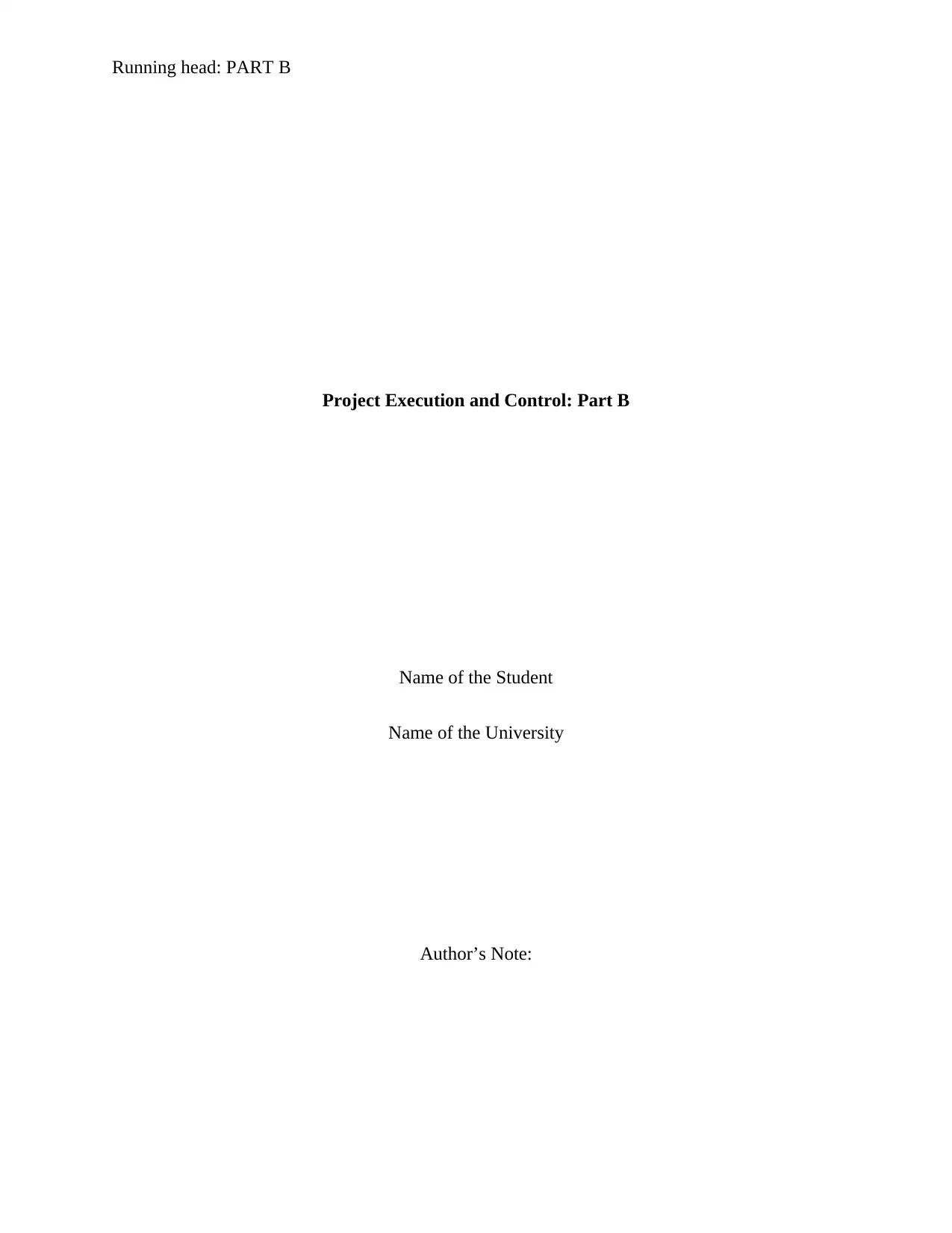
Running head: PART B
Project Execution and Control: Part B
Name of the Student
Name of the University
Author’s Note:
Project Execution and Control: Part B
Name of the Student
Name of the University
Author’s Note:
Paraphrase This Document
Need a fresh take? Get an instant paraphrase of this document with our AI Paraphraser
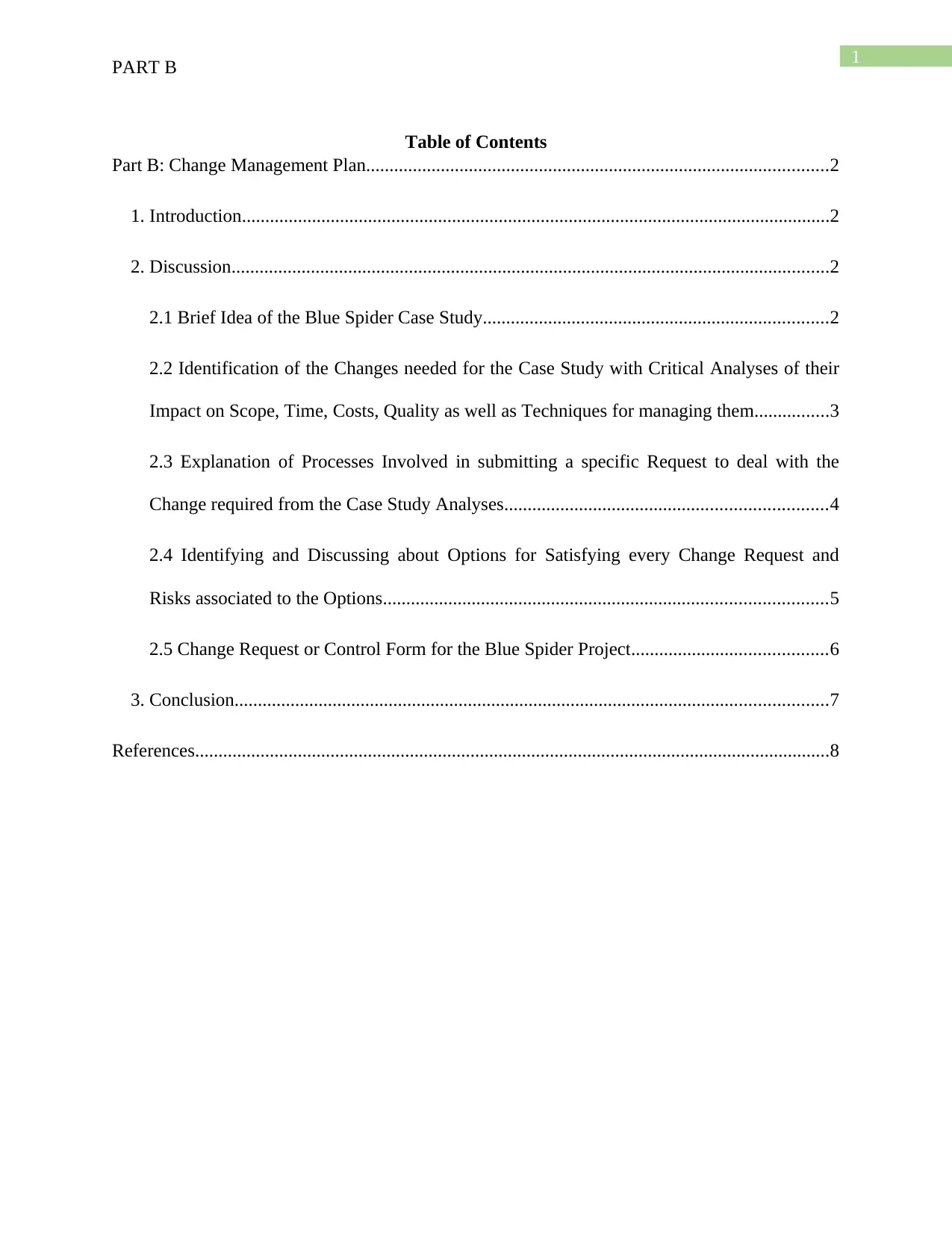
1
PART B
Table of Contents
Part B: Change Management Plan...................................................................................................2
1. Introduction..............................................................................................................................2
2. Discussion................................................................................................................................2
2.1 Brief Idea of the Blue Spider Case Study..........................................................................2
2.2 Identification of the Changes needed for the Case Study with Critical Analyses of their
Impact on Scope, Time, Costs, Quality as well as Techniques for managing them................3
2.3 Explanation of Processes Involved in submitting a specific Request to deal with the
Change required from the Case Study Analyses.....................................................................4
2.4 Identifying and Discussing about Options for Satisfying every Change Request and
Risks associated to the Options...............................................................................................5
2.5 Change Request or Control Form for the Blue Spider Project..........................................6
3. Conclusion...............................................................................................................................7
References........................................................................................................................................8
PART B
Table of Contents
Part B: Change Management Plan...................................................................................................2
1. Introduction..............................................................................................................................2
2. Discussion................................................................................................................................2
2.1 Brief Idea of the Blue Spider Case Study..........................................................................2
2.2 Identification of the Changes needed for the Case Study with Critical Analyses of their
Impact on Scope, Time, Costs, Quality as well as Techniques for managing them................3
2.3 Explanation of Processes Involved in submitting a specific Request to deal with the
Change required from the Case Study Analyses.....................................................................4
2.4 Identifying and Discussing about Options for Satisfying every Change Request and
Risks associated to the Options...............................................................................................5
2.5 Change Request or Control Form for the Blue Spider Project..........................................6
3. Conclusion...............................................................................................................................7
References........................................................................................................................................8
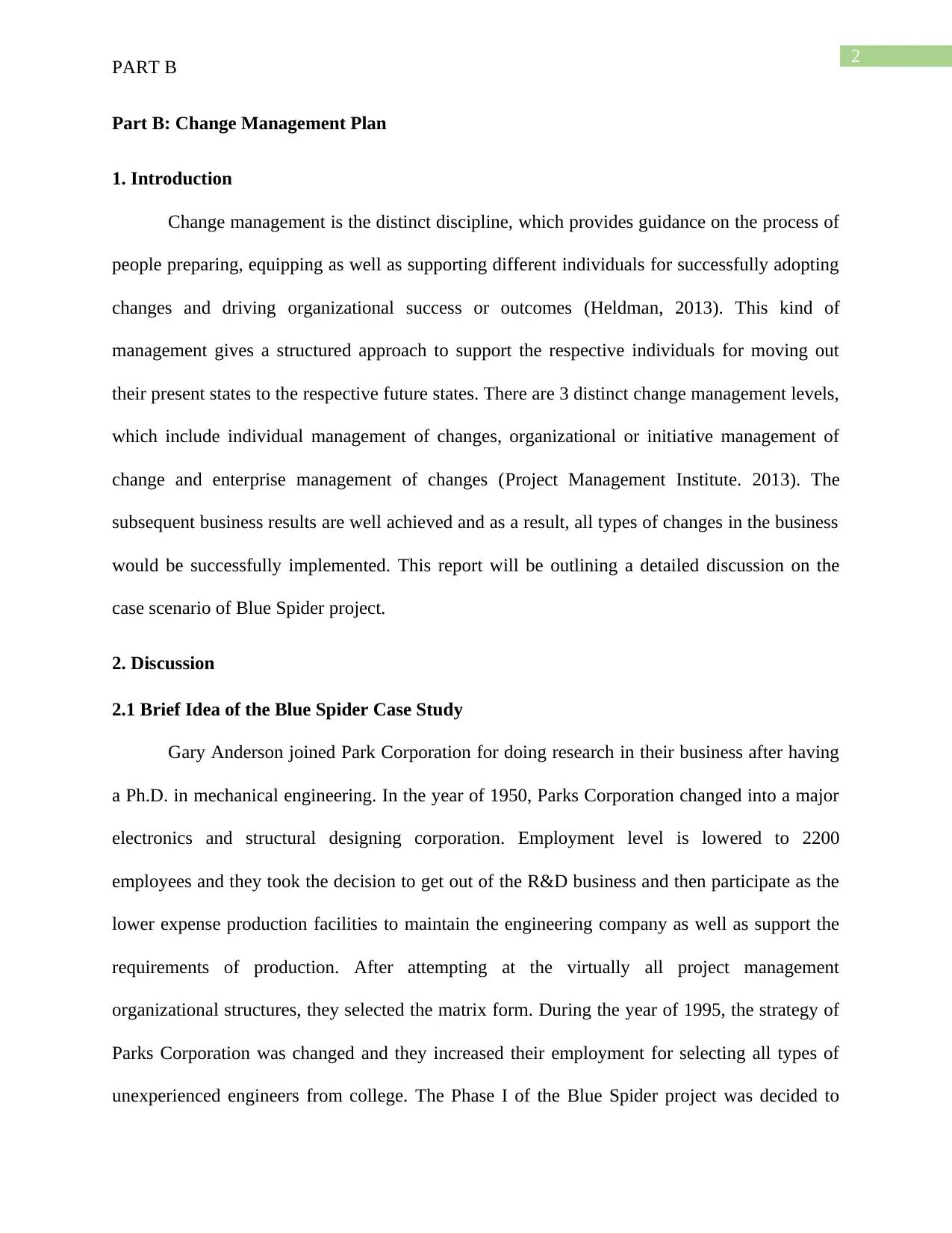
2
PART B
Part B: Change Management Plan
1. Introduction
Change management is the distinct discipline, which provides guidance on the process of
people preparing, equipping as well as supporting different individuals for successfully adopting
changes and driving organizational success or outcomes (Heldman, 2013). This kind of
management gives a structured approach to support the respective individuals for moving out
their present states to the respective future states. There are 3 distinct change management levels,
which include individual management of changes, organizational or initiative management of
change and enterprise management of changes (Project Management Institute. 2013). The
subsequent business results are well achieved and as a result, all types of changes in the business
would be successfully implemented. This report will be outlining a detailed discussion on the
case scenario of Blue Spider project.
2. Discussion
2.1 Brief Idea of the Blue Spider Case Study
Gary Anderson joined Park Corporation for doing research in their business after having
a Ph.D. in mechanical engineering. In the year of 1950, Parks Corporation changed into a major
electronics and structural designing corporation. Employment level is lowered to 2200
employees and they took the decision to get out of the R&D business and then participate as the
lower expense production facilities to maintain the engineering company as well as support the
requirements of production. After attempting at the virtually all project management
organizational structures, they selected the matrix form. During the year of 1995, the strategy of
Parks Corporation was changed and they increased their employment for selecting all types of
unexperienced engineers from college. The Phase I of the Blue Spider project was decided to
PART B
Part B: Change Management Plan
1. Introduction
Change management is the distinct discipline, which provides guidance on the process of
people preparing, equipping as well as supporting different individuals for successfully adopting
changes and driving organizational success or outcomes (Heldman, 2013). This kind of
management gives a structured approach to support the respective individuals for moving out
their present states to the respective future states. There are 3 distinct change management levels,
which include individual management of changes, organizational or initiative management of
change and enterprise management of changes (Project Management Institute. 2013). The
subsequent business results are well achieved and as a result, all types of changes in the business
would be successfully implemented. This report will be outlining a detailed discussion on the
case scenario of Blue Spider project.
2. Discussion
2.1 Brief Idea of the Blue Spider Case Study
Gary Anderson joined Park Corporation for doing research in their business after having
a Ph.D. in mechanical engineering. In the year of 1950, Parks Corporation changed into a major
electronics and structural designing corporation. Employment level is lowered to 2200
employees and they took the decision to get out of the R&D business and then participate as the
lower expense production facilities to maintain the engineering company as well as support the
requirements of production. After attempting at the virtually all project management
organizational structures, they selected the matrix form. During the year of 1995, the strategy of
Parks Corporation was changed and they increased their employment for selecting all types of
unexperienced engineers from college. The Phase I of the Blue Spider project was decided to
⊘ This is a preview!⊘
Do you want full access?
Subscribe today to unlock all pages.

Trusted by 1+ million students worldwide
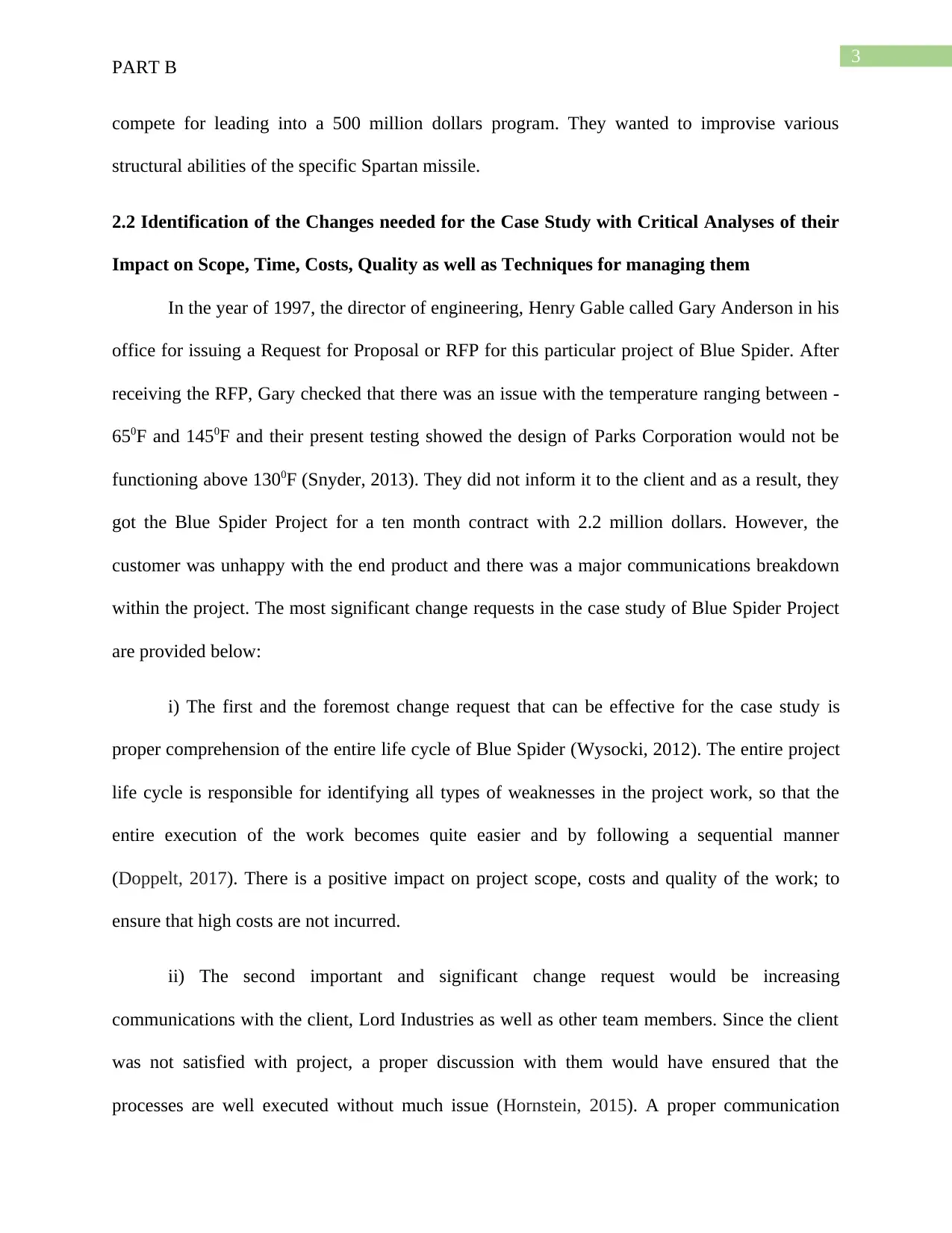
3
PART B
compete for leading into a 500 million dollars program. They wanted to improvise various
structural abilities of the specific Spartan missile.
2.2 Identification of the Changes needed for the Case Study with Critical Analyses of their
Impact on Scope, Time, Costs, Quality as well as Techniques for managing them
In the year of 1997, the director of engineering, Henry Gable called Gary Anderson in his
office for issuing a Request for Proposal or RFP for this particular project of Blue Spider. After
receiving the RFP, Gary checked that there was an issue with the temperature ranging between -
650F and 1450F and their present testing showed the design of Parks Corporation would not be
functioning above 1300F (Snyder, 2013). They did not inform it to the client and as a result, they
got the Blue Spider Project for a ten month contract with 2.2 million dollars. However, the
customer was unhappy with the end product and there was a major communications breakdown
within the project. The most significant change requests in the case study of Blue Spider Project
are provided below:
i) The first and the foremost change request that can be effective for the case study is
proper comprehension of the entire life cycle of Blue Spider (Wysocki, 2012). The entire project
life cycle is responsible for identifying all types of weaknesses in the project work, so that the
entire execution of the work becomes quite easier and by following a sequential manner
(Doppelt, 2017). There is a positive impact on project scope, costs and quality of the work; to
ensure that high costs are not incurred.
ii) The second important and significant change request would be increasing
communications with the client, Lord Industries as well as other team members. Since the client
was not satisfied with project, a proper discussion with them would have ensured that the
processes are well executed without much issue (Hornstein, 2015). A proper communication
PART B
compete for leading into a 500 million dollars program. They wanted to improvise various
structural abilities of the specific Spartan missile.
2.2 Identification of the Changes needed for the Case Study with Critical Analyses of their
Impact on Scope, Time, Costs, Quality as well as Techniques for managing them
In the year of 1997, the director of engineering, Henry Gable called Gary Anderson in his
office for issuing a Request for Proposal or RFP for this particular project of Blue Spider. After
receiving the RFP, Gary checked that there was an issue with the temperature ranging between -
650F and 1450F and their present testing showed the design of Parks Corporation would not be
functioning above 1300F (Snyder, 2013). They did not inform it to the client and as a result, they
got the Blue Spider Project for a ten month contract with 2.2 million dollars. However, the
customer was unhappy with the end product and there was a major communications breakdown
within the project. The most significant change requests in the case study of Blue Spider Project
are provided below:
i) The first and the foremost change request that can be effective for the case study is
proper comprehension of the entire life cycle of Blue Spider (Wysocki, 2012). The entire project
life cycle is responsible for identifying all types of weaknesses in the project work, so that the
entire execution of the work becomes quite easier and by following a sequential manner
(Doppelt, 2017). There is a positive impact on project scope, costs and quality of the work; to
ensure that high costs are not incurred.
ii) The second important and significant change request would be increasing
communications with the client, Lord Industries as well as other team members. Since the client
was not satisfied with project, a proper discussion with them would have ensured that the
processes are well executed without much issue (Hornstein, 2015). A proper communication
Paraphrase This Document
Need a fresh take? Get an instant paraphrase of this document with our AI Paraphraser
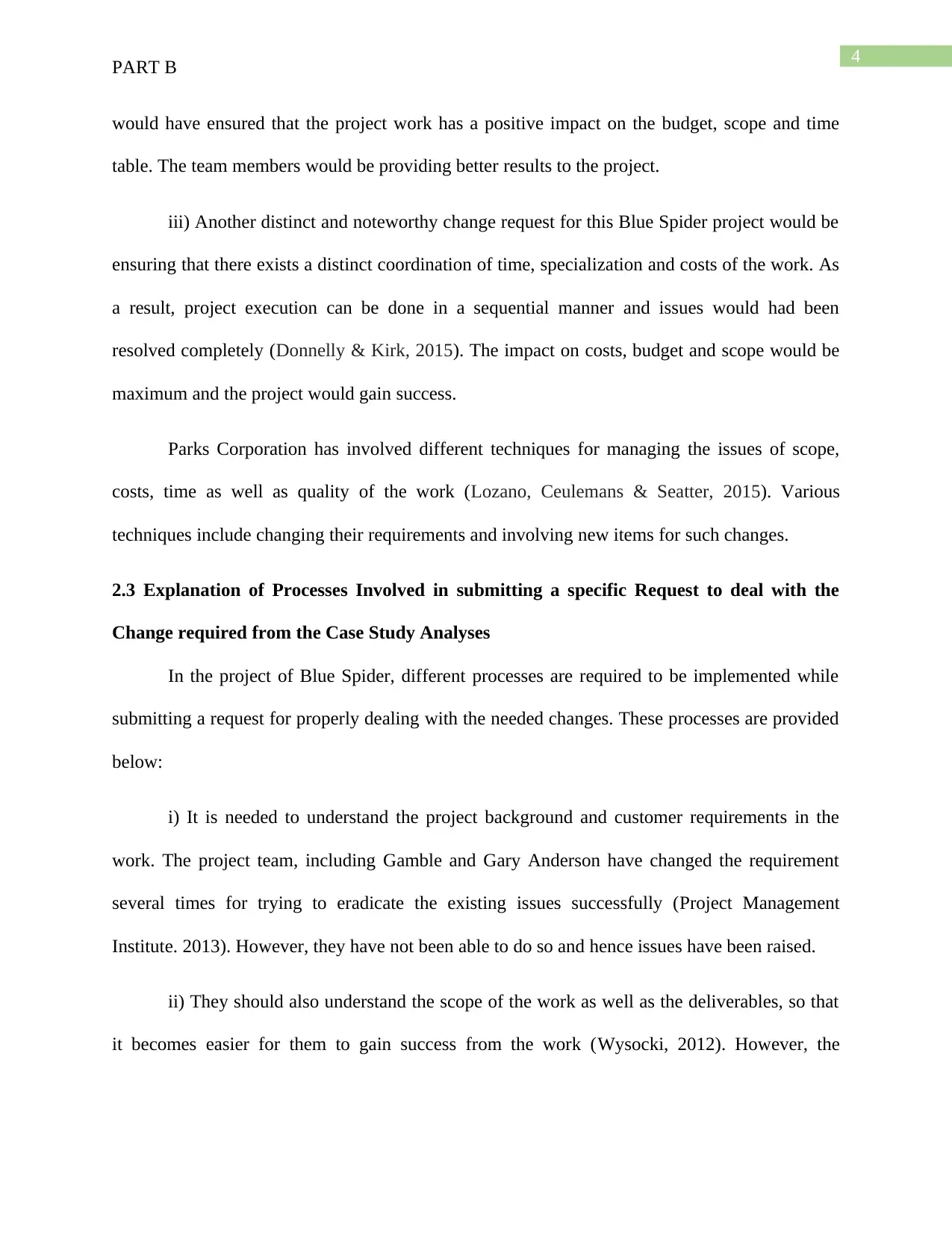
4
PART B
would have ensured that the project work has a positive impact on the budget, scope and time
table. The team members would be providing better results to the project.
iii) Another distinct and noteworthy change request for this Blue Spider project would be
ensuring that there exists a distinct coordination of time, specialization and costs of the work. As
a result, project execution can be done in a sequential manner and issues would had been
resolved completely (Donnelly & Kirk, 2015). The impact on costs, budget and scope would be
maximum and the project would gain success.
Parks Corporation has involved different techniques for managing the issues of scope,
costs, time as well as quality of the work (Lozano, Ceulemans & Seatter, 2015). Various
techniques include changing their requirements and involving new items for such changes.
2.3 Explanation of Processes Involved in submitting a specific Request to deal with the
Change required from the Case Study Analyses
In the project of Blue Spider, different processes are required to be implemented while
submitting a request for properly dealing with the needed changes. These processes are provided
below:
i) It is needed to understand the project background and customer requirements in the
work. The project team, including Gamble and Gary Anderson have changed the requirement
several times for trying to eradicate the existing issues successfully (Project Management
Institute. 2013). However, they have not been able to do so and hence issues have been raised.
ii) They should also understand the scope of the work as well as the deliverables, so that
it becomes easier for them to gain success from the work (Wysocki, 2012). However, the
PART B
would have ensured that the project work has a positive impact on the budget, scope and time
table. The team members would be providing better results to the project.
iii) Another distinct and noteworthy change request for this Blue Spider project would be
ensuring that there exists a distinct coordination of time, specialization and costs of the work. As
a result, project execution can be done in a sequential manner and issues would had been
resolved completely (Donnelly & Kirk, 2015). The impact on costs, budget and scope would be
maximum and the project would gain success.
Parks Corporation has involved different techniques for managing the issues of scope,
costs, time as well as quality of the work (Lozano, Ceulemans & Seatter, 2015). Various
techniques include changing their requirements and involving new items for such changes.
2.3 Explanation of Processes Involved in submitting a specific Request to deal with the
Change required from the Case Study Analyses
In the project of Blue Spider, different processes are required to be implemented while
submitting a request for properly dealing with the needed changes. These processes are provided
below:
i) It is needed to understand the project background and customer requirements in the
work. The project team, including Gamble and Gary Anderson have changed the requirement
several times for trying to eradicate the existing issues successfully (Project Management
Institute. 2013). However, they have not been able to do so and hence issues have been raised.
ii) They should also understand the scope of the work as well as the deliverables, so that
it becomes easier for them to gain success from the work (Wysocki, 2012). However, the
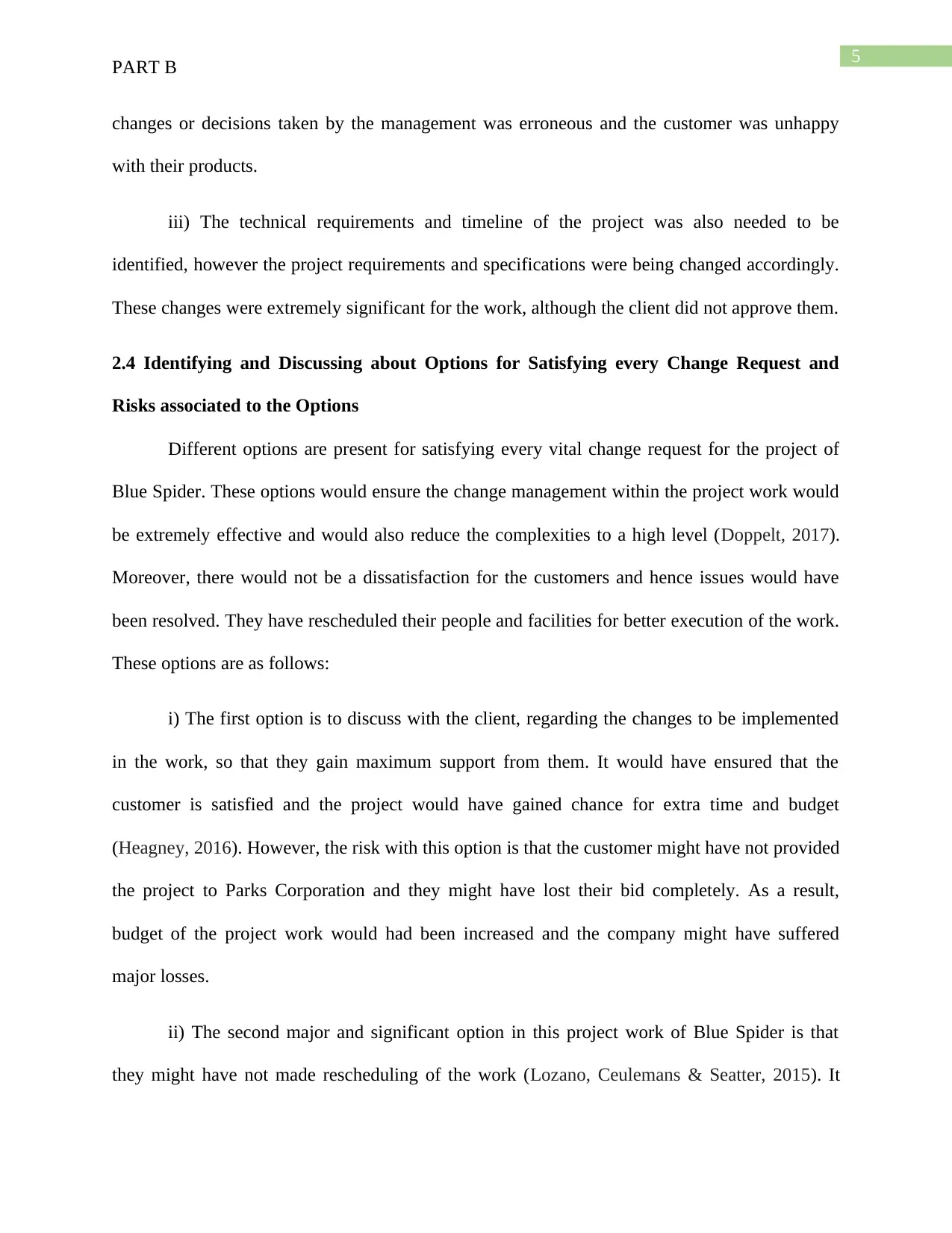
5
PART B
changes or decisions taken by the management was erroneous and the customer was unhappy
with their products.
iii) The technical requirements and timeline of the project was also needed to be
identified, however the project requirements and specifications were being changed accordingly.
These changes were extremely significant for the work, although the client did not approve them.
2.4 Identifying and Discussing about Options for Satisfying every Change Request and
Risks associated to the Options
Different options are present for satisfying every vital change request for the project of
Blue Spider. These options would ensure the change management within the project work would
be extremely effective and would also reduce the complexities to a high level (Doppelt, 2017).
Moreover, there would not be a dissatisfaction for the customers and hence issues would have
been resolved. They have rescheduled their people and facilities for better execution of the work.
These options are as follows:
i) The first option is to discuss with the client, regarding the changes to be implemented
in the work, so that they gain maximum support from them. It would have ensured that the
customer is satisfied and the project would have gained chance for extra time and budget
(Heagney, 2016). However, the risk with this option is that the customer might have not provided
the project to Parks Corporation and they might have lost their bid completely. As a result,
budget of the project work would had been increased and the company might have suffered
major losses.
ii) The second major and significant option in this project work of Blue Spider is that
they might have not made rescheduling of the work (Lozano, Ceulemans & Seatter, 2015). It
PART B
changes or decisions taken by the management was erroneous and the customer was unhappy
with their products.
iii) The technical requirements and timeline of the project was also needed to be
identified, however the project requirements and specifications were being changed accordingly.
These changes were extremely significant for the work, although the client did not approve them.
2.4 Identifying and Discussing about Options for Satisfying every Change Request and
Risks associated to the Options
Different options are present for satisfying every vital change request for the project of
Blue Spider. These options would ensure the change management within the project work would
be extremely effective and would also reduce the complexities to a high level (Doppelt, 2017).
Moreover, there would not be a dissatisfaction for the customers and hence issues would have
been resolved. They have rescheduled their people and facilities for better execution of the work.
These options are as follows:
i) The first option is to discuss with the client, regarding the changes to be implemented
in the work, so that they gain maximum support from them. It would have ensured that the
customer is satisfied and the project would have gained chance for extra time and budget
(Heagney, 2016). However, the risk with this option is that the customer might have not provided
the project to Parks Corporation and they might have lost their bid completely. As a result,
budget of the project work would had been increased and the company might have suffered
major losses.
ii) The second major and significant option in this project work of Blue Spider is that
they might have not made rescheduling of the work (Lozano, Ceulemans & Seatter, 2015). It
⊘ This is a preview!⊘
Do you want full access?
Subscribe today to unlock all pages.

Trusted by 1+ million students worldwide
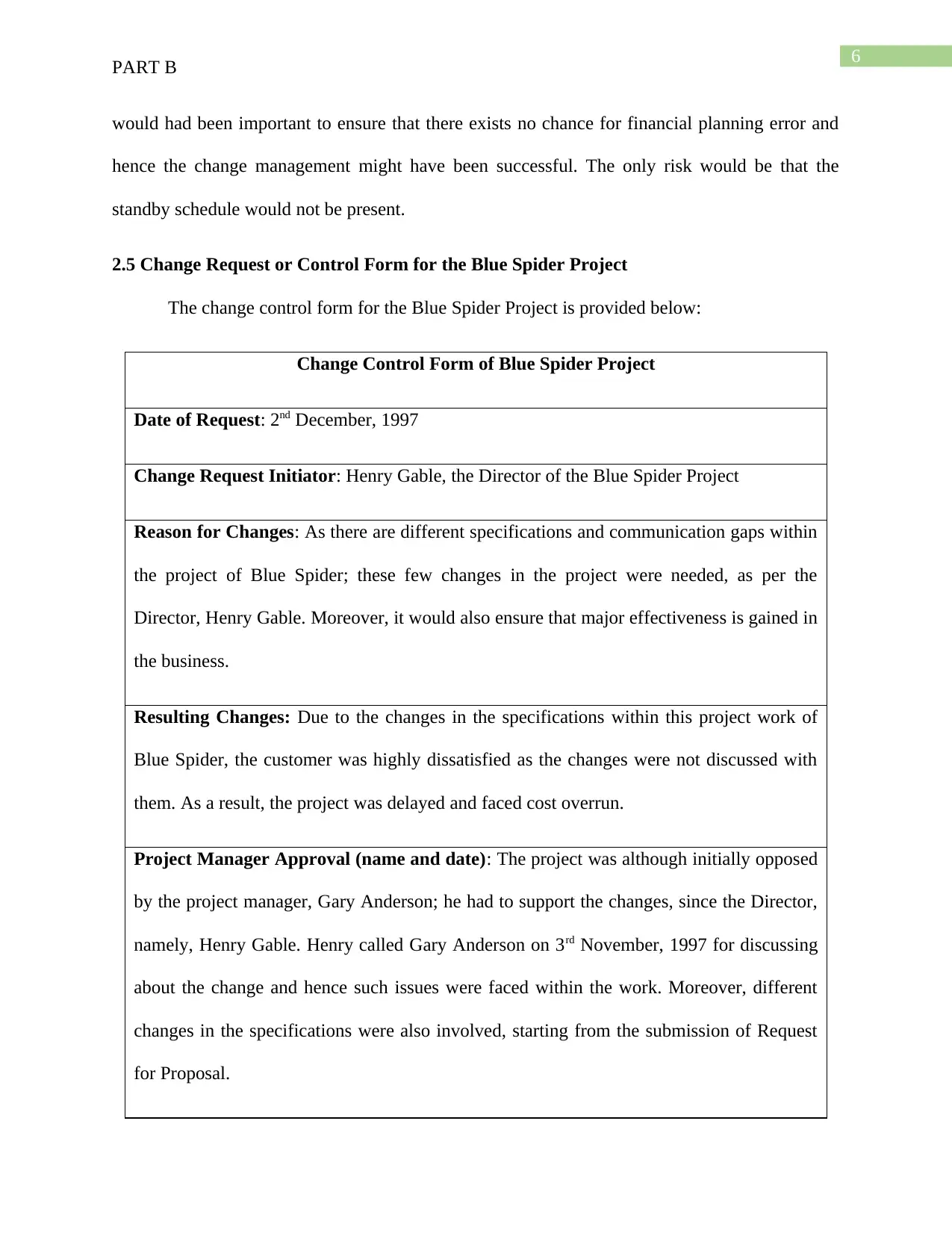
6
PART B
would had been important to ensure that there exists no chance for financial planning error and
hence the change management might have been successful. The only risk would be that the
standby schedule would not be present.
2.5 Change Request or Control Form for the Blue Spider Project
The change control form for the Blue Spider Project is provided below:
Change Control Form of Blue Spider Project
Date of Request: 2nd December, 1997
Change Request Initiator: Henry Gable, the Director of the Blue Spider Project
Reason for Changes: As there are different specifications and communication gaps within
the project of Blue Spider; these few changes in the project were needed, as per the
Director, Henry Gable. Moreover, it would also ensure that major effectiveness is gained in
the business.
Resulting Changes: Due to the changes in the specifications within this project work of
Blue Spider, the customer was highly dissatisfied as the changes were not discussed with
them. As a result, the project was delayed and faced cost overrun.
Project Manager Approval (name and date): The project was although initially opposed
by the project manager, Gary Anderson; he had to support the changes, since the Director,
namely, Henry Gable. Henry called Gary Anderson on 3rd November, 1997 for discussing
about the change and hence such issues were faced within the work. Moreover, different
changes in the specifications were also involved, starting from the submission of Request
for Proposal.
PART B
would had been important to ensure that there exists no chance for financial planning error and
hence the change management might have been successful. The only risk would be that the
standby schedule would not be present.
2.5 Change Request or Control Form for the Blue Spider Project
The change control form for the Blue Spider Project is provided below:
Change Control Form of Blue Spider Project
Date of Request: 2nd December, 1997
Change Request Initiator: Henry Gable, the Director of the Blue Spider Project
Reason for Changes: As there are different specifications and communication gaps within
the project of Blue Spider; these few changes in the project were needed, as per the
Director, Henry Gable. Moreover, it would also ensure that major effectiveness is gained in
the business.
Resulting Changes: Due to the changes in the specifications within this project work of
Blue Spider, the customer was highly dissatisfied as the changes were not discussed with
them. As a result, the project was delayed and faced cost overrun.
Project Manager Approval (name and date): The project was although initially opposed
by the project manager, Gary Anderson; he had to support the changes, since the Director,
namely, Henry Gable. Henry called Gary Anderson on 3rd November, 1997 for discussing
about the change and hence such issues were faced within the work. Moreover, different
changes in the specifications were also involved, starting from the submission of Request
for Proposal.
Paraphrase This Document
Need a fresh take? Get an instant paraphrase of this document with our AI Paraphraser
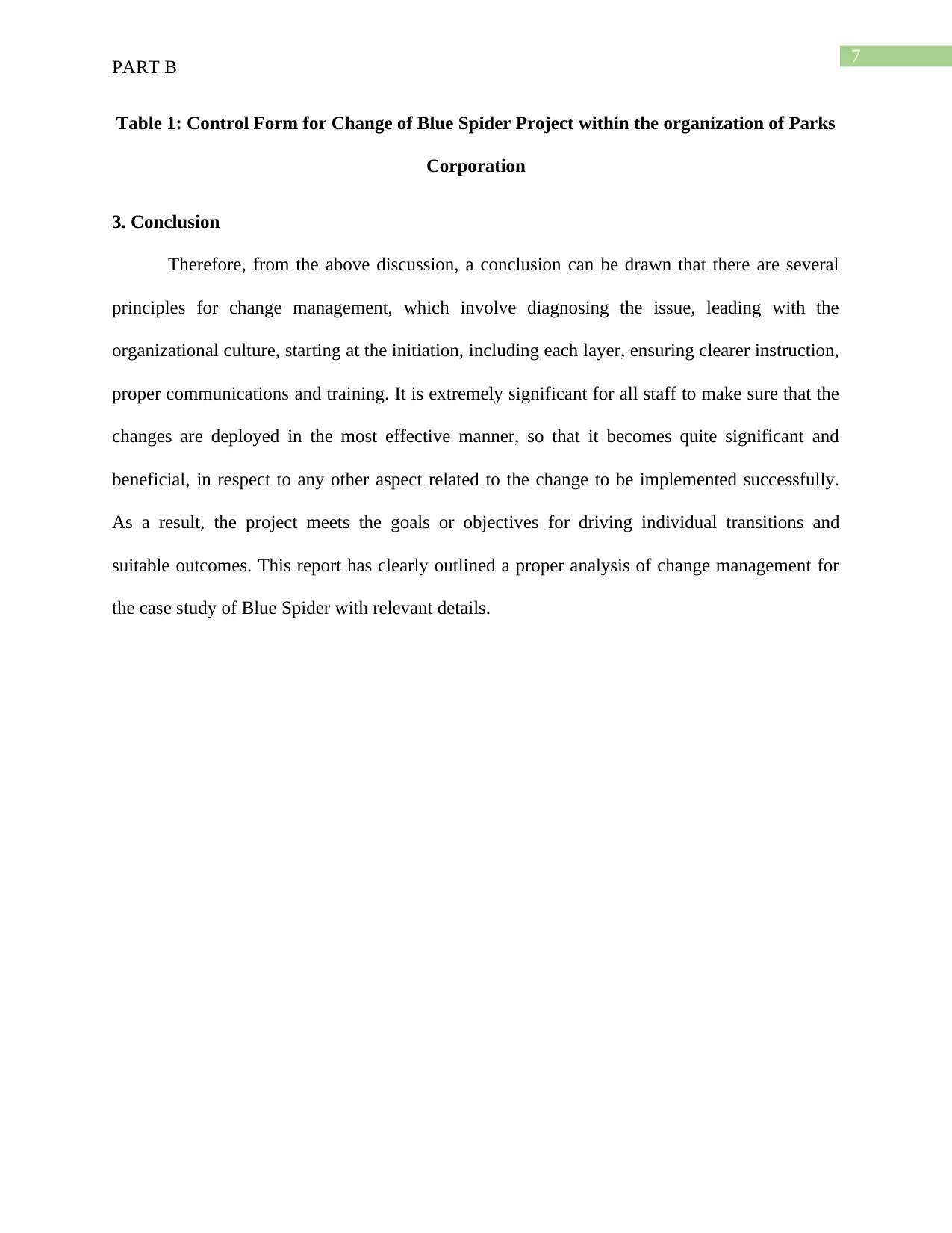
7
PART B
Table 1: Control Form for Change of Blue Spider Project within the organization of Parks
Corporation
3. Conclusion
Therefore, from the above discussion, a conclusion can be drawn that there are several
principles for change management, which involve diagnosing the issue, leading with the
organizational culture, starting at the initiation, including each layer, ensuring clearer instruction,
proper communications and training. It is extremely significant for all staff to make sure that the
changes are deployed in the most effective manner, so that it becomes quite significant and
beneficial, in respect to any other aspect related to the change to be implemented successfully.
As a result, the project meets the goals or objectives for driving individual transitions and
suitable outcomes. This report has clearly outlined a proper analysis of change management for
the case study of Blue Spider with relevant details.
PART B
Table 1: Control Form for Change of Blue Spider Project within the organization of Parks
Corporation
3. Conclusion
Therefore, from the above discussion, a conclusion can be drawn that there are several
principles for change management, which involve diagnosing the issue, leading with the
organizational culture, starting at the initiation, including each layer, ensuring clearer instruction,
proper communications and training. It is extremely significant for all staff to make sure that the
changes are deployed in the most effective manner, so that it becomes quite significant and
beneficial, in respect to any other aspect related to the change to be implemented successfully.
As a result, the project meets the goals or objectives for driving individual transitions and
suitable outcomes. This report has clearly outlined a proper analysis of change management for
the case study of Blue Spider with relevant details.
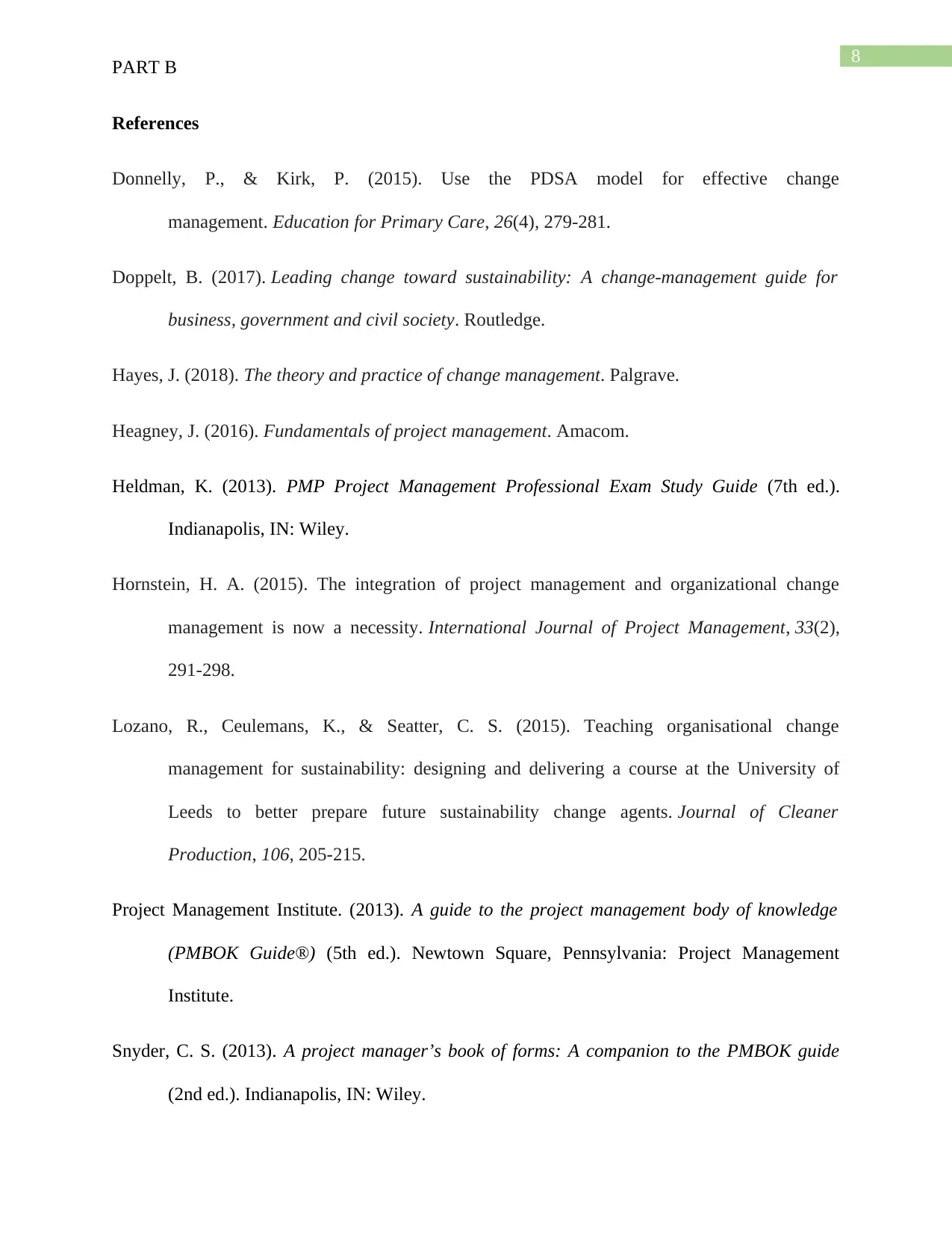
8
PART B
References
Donnelly, P., & Kirk, P. (2015). Use the PDSA model for effective change
management. Education for Primary Care, 26(4), 279-281.
Doppelt, B. (2017). Leading change toward sustainability: A change-management guide for
business, government and civil society. Routledge.
Hayes, J. (2018). The theory and practice of change management. Palgrave.
Heagney, J. (2016). Fundamentals of project management. Amacom.
Heldman, K. (2013). PMP Project Management Professional Exam Study Guide (7th ed.).
Indianapolis, IN: Wiley.
Hornstein, H. A. (2015). The integration of project management and organizational change
management is now a necessity. International Journal of Project Management, 33(2),
291-298.
Lozano, R., Ceulemans, K., & Seatter, C. S. (2015). Teaching organisational change
management for sustainability: designing and delivering a course at the University of
Leeds to better prepare future sustainability change agents. Journal of Cleaner
Production, 106, 205-215.
Project Management Institute. (2013). A guide to the project management body of knowledge
(PMBOK Guide®) (5th ed.). Newtown Square, Pennsylvania: Project Management
Institute.
Snyder, C. S. (2013). A project manager’s book of forms: A companion to the PMBOK guide
(2nd ed.). Indianapolis, IN: Wiley.
PART B
References
Donnelly, P., & Kirk, P. (2015). Use the PDSA model for effective change
management. Education for Primary Care, 26(4), 279-281.
Doppelt, B. (2017). Leading change toward sustainability: A change-management guide for
business, government and civil society. Routledge.
Hayes, J. (2018). The theory and practice of change management. Palgrave.
Heagney, J. (2016). Fundamentals of project management. Amacom.
Heldman, K. (2013). PMP Project Management Professional Exam Study Guide (7th ed.).
Indianapolis, IN: Wiley.
Hornstein, H. A. (2015). The integration of project management and organizational change
management is now a necessity. International Journal of Project Management, 33(2),
291-298.
Lozano, R., Ceulemans, K., & Seatter, C. S. (2015). Teaching organisational change
management for sustainability: designing and delivering a course at the University of
Leeds to better prepare future sustainability change agents. Journal of Cleaner
Production, 106, 205-215.
Project Management Institute. (2013). A guide to the project management body of knowledge
(PMBOK Guide®) (5th ed.). Newtown Square, Pennsylvania: Project Management
Institute.
Snyder, C. S. (2013). A project manager’s book of forms: A companion to the PMBOK guide
(2nd ed.). Indianapolis, IN: Wiley.
⊘ This is a preview!⊘
Do you want full access?
Subscribe today to unlock all pages.

Trusted by 1+ million students worldwide

9
PART B
Wysocki, R. K. (2012). Effective Project Management: Traditional, Agile, Extreme (6th ed.).
Indianapolis, IN: Wiley.
PART B
Wysocki, R. K. (2012). Effective Project Management: Traditional, Agile, Extreme (6th ed.).
Indianapolis, IN: Wiley.
1 out of 10
Related Documents
Your All-in-One AI-Powered Toolkit for Academic Success.
+13062052269
info@desklib.com
Available 24*7 on WhatsApp / Email
![[object Object]](/_next/static/media/star-bottom.7253800d.svg)
Unlock your academic potential
Copyright © 2020–2025 A2Z Services. All Rights Reserved. Developed and managed by ZUCOL.





